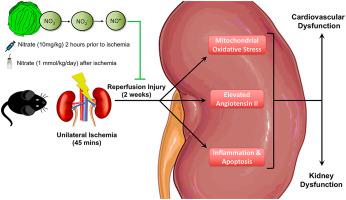Redox Biology ( IF 11.4 ) Pub Date : 2020-12-17 , DOI: 10.1016/j.redox.2020.101836 Gensheng Zhang 1 , Huirong Han 2 , Zhengbing Zhuge 3 , Fang Dong 4 , Shan Jiang 4 , Wenwen Wang 5 , Drielle D Guimarães 3 , Tomas A Schiffer 3 , En Yin Lai 4 , Lucas Rannier Ribeiro Antonino Carvalho 6 , Ricardo Barbosa Lucena 7 , Valdir A Braga 6 , Eddie Weitzberg 3 , Jon O Lundberg 3 , Mattias Carlstrom 3

|
Background
Renal ischemia-reperfusion (IR) injury is a common cause of acute kidney injury (AKI), which is associated with oxidative stress and reduced nitric oxide (NO) bioactivity and increased risk of developing chronic kidney disease (CKD) and cardiovascular disease (CVD). New strategies that restore redox balance may have therapeutic implications during AKI and associated complications.
Aim
To investigate the therapeutic value of boosting the nitrate-nitrite-NO pathway during development of IR-induced renal and cardiovascular dysfunction.
Methods
Male C57BL/6 J mice were given sodium nitrate (10 mg/kg, i. p) or vehicle 2 h prior to warm ischemia of the left kidney (45 min) followed by sodium nitrate supplementation in the drinking water (1 mmol/kg/day) for the following 2 weeks. Blood pressure and glomerular filtration rate were measured and blood and kidneys were collected and used for biochemical and histological analyses as well as renal vessel reactivity studies. Glomerular endothelial cells exposed to hypoxia-reoxygenation, with or without angiotensin II, were used for mechanistic studies.
Results
IR was associated with reduced renal function and slightly elevated blood pressure, in combination with renal injuries, inflammation, endothelial dysfunction, increased Ang II levels and Ang II-mediated vasoreactivity, which were all ameliorated by nitrate. Moreover, treatment with nitrate (in vivo) and nitrite (in vitro) restored NO bioactivity and reduced mitochondrial oxidative stress and injuries.
Conclusions
Acute treatment with inorganic nitrate prior to renal ischemia may serve as a novel therapeutic approach to prevent AKI and CKD and associated risk of developing cardiovascular dysfunction.
中文翻译:

肾脏缺血再灌注后无机硝酸盐的肾血管作用
背景
肾缺血再灌注(IR)损伤是急性肾损伤(AKI)的常见原因,其与氧化应激和一氧化氮(NO)生物活性降低以及患慢性肾脏病(CKD)和心血管疾病(CVD)的风险增加相关)。恢复氧化还原平衡的新策略可能在AKI和相关并发症中具有治疗意义。
目标
目的探讨在IR诱发的肾功能和心血管功能障碍发展过程中增强硝酸盐-亚硝酸盐-NO途径的治疗价值。
方法
雄性C57BL / 6 J小鼠在左肾热缺血(45分钟)之前2小时接受硝酸钠(10 mg / kg,腹腔注射)或溶媒给药,然后在饮用水中补充硝酸钠(1 mmol / kg) /天),接下来的2周。测量血压和肾小球滤过率,收集血液和肾脏,用于生化和组织学分析以及肾血管反应性研究。暴露于低氧-复氧的肾小球内皮细胞,有或没有血管紧张素II,用于机制研究。
结果
IR与肾功能降低和血压略高相关,并伴有肾损伤,炎症,内皮功能障碍,Ang II水平升高和Ang II介导的血管反应性,所有这些均可通过硝酸盐改善。此外,用硝酸盐(体内)和亚硝酸盐(体外)治疗可以恢复NO的生物活性,并减少线粒体的氧化应激和伤害。
结论
肾缺血之前用无机硝酸盐进行的急性治疗可能是预防AKI和CKD以及发展为心血管功能障碍的相关风险的一种新型治疗方法。



























 京公网安备 11010802027423号
京公网安备 11010802027423号